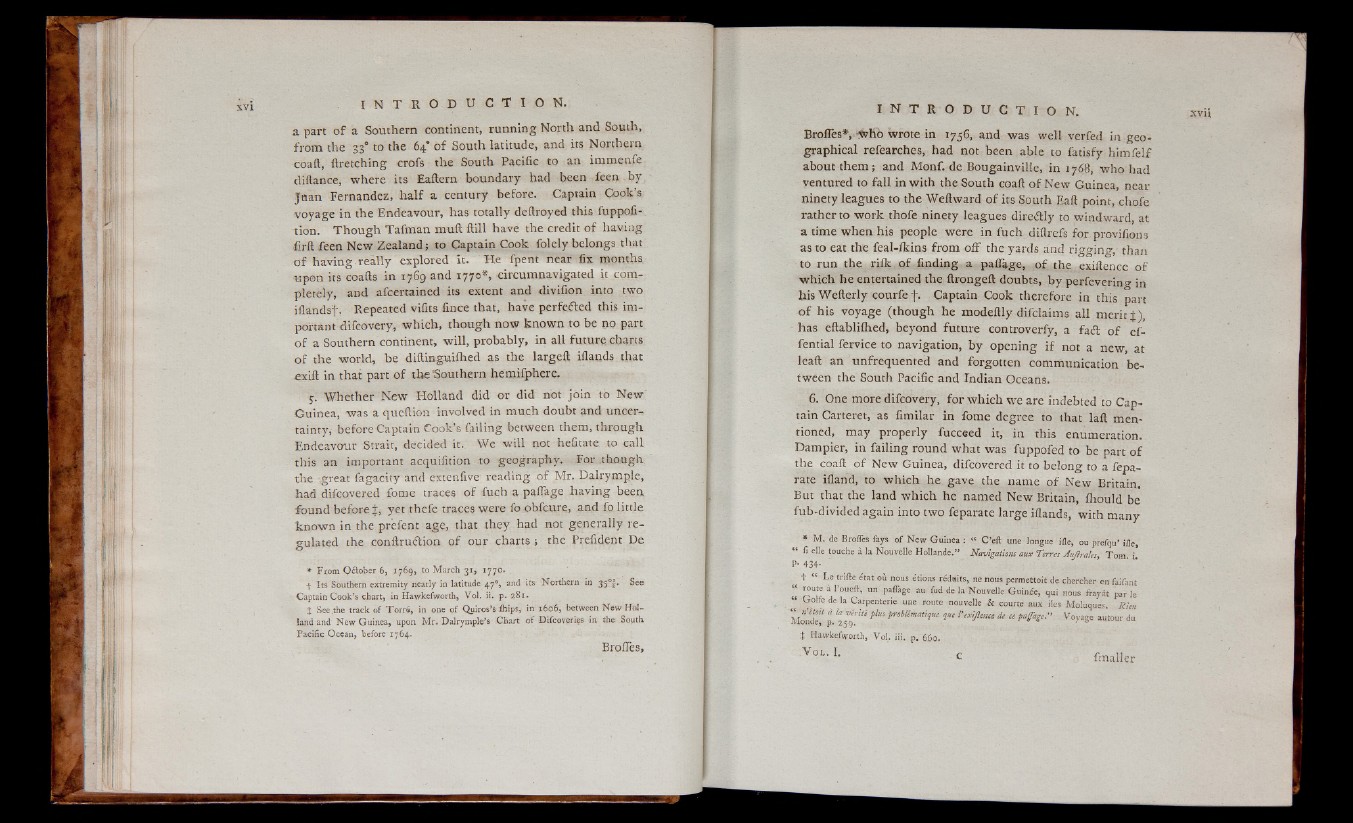
a part of a Southern continent, running North and South,
froth the 33* to the 64* of South latitude, and its Northern
coaft, ftretching crofs the South Pacific to an immenfe
diftance, where its Eaftern boundary had heen feen by,
Jaan Fernandez, half a century before. Captain Cook’s
voyage in the Endeavour, has totally deftroyed this fuppofi-
tion. Though Tafman muft ftill have the credit of having
firft feen New Zealand ; to Captain Cook folely belongs that
o f having really explored it. He fpent near fix months
upon its coafts in 1769 and 1770*, circumnavigated it completely,
and afcertained its extent and divifion into two
iflandsf. Repeated vifits fince that, have perfected this important
difcovery, which, though now known to be no part
of a Southern continent, will, probably, in all future charts
of the world, be diftiaguiihed as the largeft iflands that
exift in that part of the ‘Southern hemifphere.
5. Whether New Holland did or did not join to New
Guinea, was a queftion involved in much doubt and uncertainty,
before Captain Cook’s failing between them, through
Endeavour Strait, decided it. We will not hefitate to call
this an important acquifition to geography. For though
the great fagacity and extenfive reading of Mr. Dalrymple,
had difcovered fome traces of fuch a pafiage having been
found before Jj yet thefe traces were fo ohfeure, and fo little
known in the prêfent age, that they had not generally regulated
the conftruclion of our charts ; the Prefident De
* From Qftober 6, 1769, to March 31, 1770.
■f Its Southern extremity nearly in latitude 47% and. its Northern in 35°f. bee
Captain Cook’s chart, in Hawkefworth, Vol. ii. p. 381.
J See .the track of Torrs, in one of Quiros’S ihips, in 1606, between New Holland
and New Guinea, upon Mr. Dalrymple’s Chart o f Difcoveri.es in the South
Pacific Ocean, before 1764.
BroiTes,
Brofiès*, ■'tvlio wrote in 1756, and was well verfed in geographical
refearches, had not been able to fatisfy himfelf
about them; and Monf. de Bougainville, in 1768, who had
ventured to fall in with the South coaft o f New Guinea, near
ninety leagues to the Weftward of its South Eaft point, chofe
rather to work thofe ninety leagues dire&ly to windward, at
a time when his people were in fuch diftrefs forprovifions
as to eat the feal-fkins from off the yards and rigging, than
to run the rifk of finding a paifage, of the exiftence of
which he entertained the ftrongeft doubts, by perfevering in
his Wefterly courfe f. Captain Cook therefore in this part
o f his voyage (though he modeftly difclaims all merit J),
has eftabliihed, beyond future controverfy, a fa il of ef-
fential fervice to navigation, by opening i f not a new, at
leaft: an unfrequented and forgotten communication between
the South Pacific and Indian Oceans.
6. One more difcovery, for which we are indebted to Captain
Carteret, as fimilar in fome degree to that laft men-
tioned, may properly fucceed it, in this enumeration.
Dampier, in failing round what was fuppofed to be part of
the coaft of New Guinea, difcovered it to belong to a fepa-
rate ifland, to which he gave the name of New Britain.
But that the land which he named New Britain, ihould be
fub-divided again into two feparate large iflands, with many
* M. de BroiTes fajrs of New Guinea : | C ’eil une longue iile, ou prefqu’ iile,
“ fi elle touche à la Nouvelle Hollande.” Navigations aux Terres Aujirales, Tom i'
P- 434-
t “ Le trille état où nous étions réduits, ne nous permettait de chercher en fâifant
“ route, à l’oueft, un paffage au. fud de la Nouvelle Guinée, qui nous frayât par le
“ Golfe de la Carpenterie une route nouvelle & courte aux iles Moluques, Rien
Monde'* p S i 'PrM h iatHue: V * * « pafuge." Voyage autour du
t Hawkefworth, Vol. ni. p. 6.60.
VüL’ L c | fmaller